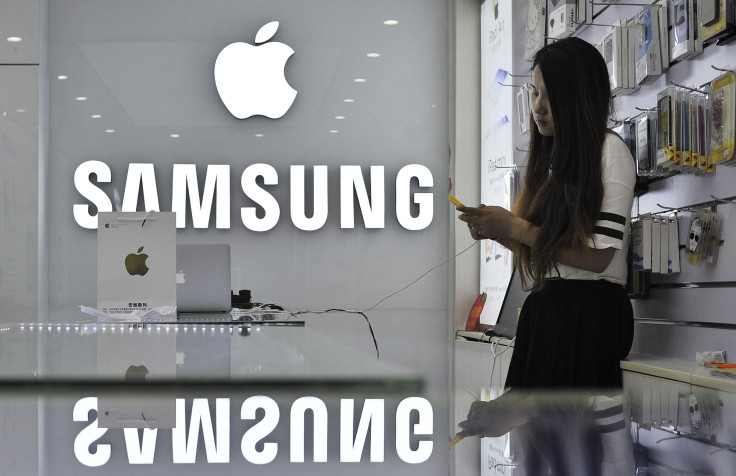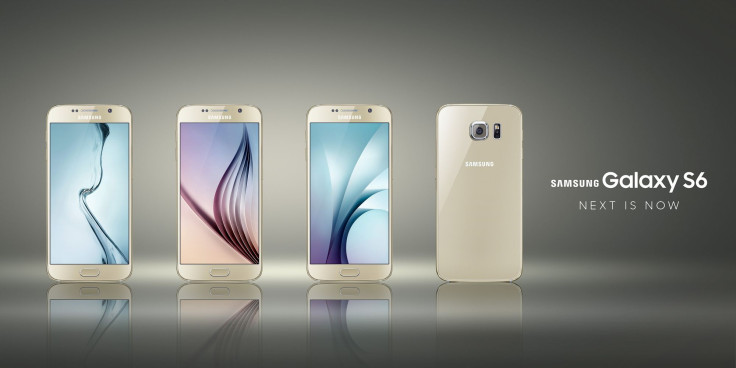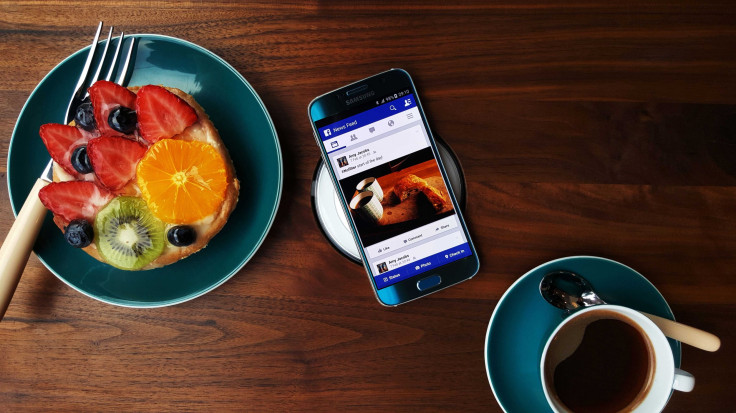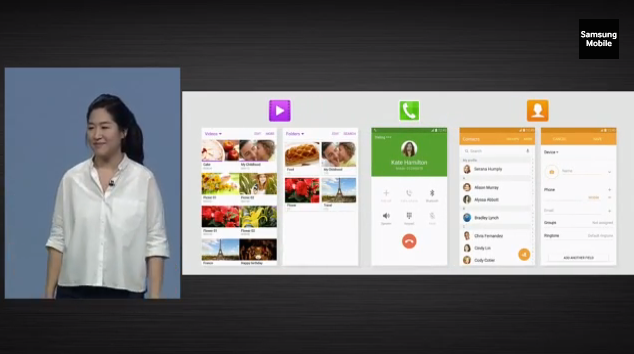Galaxy S6 vs. iPhone 6: 7 Ways Samsung’s New Flagship Just Leaped Ahead Of Apple’s Best

Samsung Electronics Co. Ltd. and Apple Inc. may see its fiercest competition yet in 2015. Samsung is ready to take the market by storm with two new handsets offering features either not found on an iPhone 6/iPhone 6 Plus or representing significant upgrades of iPhone traits.
Samsung is counting on the dual flagships to help it regain its status as the world’s top seller of smartphones.
The American Apple recently overtook the South Korean Samsung as the largest global smartphone manufacturer, having shipped 74.8 million devices during the fourth quarter of 2014, according to the research firm Gartner Inc. By comparison, Samsung shipped 73.0 million smartphones in the same quarter. Previously, Samsung had been the top smartphone maker since 2011. Last year, however, consumers got fed up with the host of carbon-copy devices Samsung released and favored the fresh design of the iPhone 6 and iPhone 6 Plus.
But with such standout features as a new metal and glass design, wireless charging and Samsung Pay, the Galaxy S6 and Galaxy S6 Edge could put Samsung back on top in market share. The manufacturer claims prerelease interest in its coming flagships is higher than it has been for any previous model. “After the unpacking, preorders for the Galaxy S6 are pouring in, and our clients’ response to the product is also very good. The products will be sold in more countries than before,” Samsung CEO J.K. Shin told Business Korea.
Here’s a look at the features on the Samsung Galaxy S6 and Galaxy S6 Edge that could give Apple a run for its money.
Fresh, New Design (With Nonbendy Metal)

Samsung has ditched its typical polycarbonate designs in favor of metal and glass on the Galaxy S6 and Galaxy S6 Edge, and the devices are already receiving rave reviews for their look and feel. Although Apple has been using metal and glass for years, Samsung said it has one-upped its rival by using a metal that is 50 percent stronger than the metal on other high-end smartphones, noting it won’t bend under pressure.
The iPhone 6 and iPhone 6 Plus were infamous for the so-called bendgate incidents that occurred upon their release: Some users found the devices would bend when they placed the handsets in their back pockets and sat down.
Back to the Galaxy S6 and Galaxy S6 Edge: The smartphones come in color options including black, blue, gold, green and white. The back panels provide a translucent look. As a result, the black model takes on a dark-bluish hue, while the gold model transitions between gold and silver, depending on its angle.
Samsung’s employment of Gorilla Glass 4 on the Galaxy S6 and Galaxy S6 Edge means the devices are pretty well protected from shattering in the event of drops. Currently, the iPhone 6 and iPhone 6 Plus use Gorilla Glass 3.
Faster In-House Processor
For the first time, Samsung is using its own brand of Exynos chips on all models of the Galaxy S6 and Galaxy S6 Edge. The Exynos 7420 chip is either beating or matching competitors, as well as older Galaxy models, in benchmark tests, indicating the Galaxy S6 and Galaxy S6 Edge are extremely powerful.
Primi sorprendenti risultati di #GalaxyS6Edge nei #Benchmark! Leggi l'articolo: http://t.co/5MZZCy8e0q pic.twitter.com/6M8x0y9Ych
- AndroidWorld.it (@androidworldit) March 2, 2015Until now, Samsung used Qualcomm Inc.’s Snapdragon systems on a chip in most of its devices. But the manufacturer has taken a hint from Apple, which uses its own A-series chips in its iPhones. Samsung executives claimed the Qualcomm Snapdragon 810 chip was not good enough for the Galaxy S6 and Galaxy S6 Edge.
Samsung stands to save money from no longer outsourcing its processing chips. Using its own silicon could also increase Samsung’s brand as a quality manufacturer and should set it apart from the many other Android smartphone makers that largely use Qualcomm.
Samsung Pay Is Compatible At Most Stores
How could Samsung one-up Apple Pay, which was poised to revolutionize mobile payments when it launched in October? The manufacturer did so by introducing Samsung Pay, a mobile-payment system that will automatically be accepted at more vendors than Apple Pay when it launches this summer.
The technology in Samsung Pay works in conjunction with the magnetic-stripe card readers already at checkout counters. Conversely, Apple Pay uses near-field communication technology, which requires special NFC readers.
Apple Pay was available at about 220,000 locations in the U.S. as of last month, according to the Wall Street Journal.
There is still a chance NFC-based systems could take off in the future, which would leave Samsung in a rush to catch up, according to eMarketer analyst Bryan Yeager. And to really make its payment system a hit, Samsung will likely have to make it available to other smartphones, IHS analyst Ian Fogg said.
Wireless Charging

The Samsung Galaxy S6 and Galaxy S6 Edge are the first devices to include built-in wireless-charging technology, meaning there is no need for extra accessories to enable wireless charging, such as special cases.
The technology is compatible with the two top wireless-charging standards -- those of the Power Matters Alliance (PMA) and Wireless Power Consortium (WPC) -- so users will be able to charge their devices wherever a charging pad is available, such as cafes, restaurants and offices. Even furniture from the retailer IKEA will feature wireless-charging capability. The idea is that a user can place a phone on a table or lamp and have it charge automatically.
The all-metal design of the iPhone 6 and iPhone 6 Plus prevents Apple from implementing wireless charging. It is likely the reason Samsung opted for a mostly glass design in the Galaxy S6 and S6 Edge.
However, filings with the U.S. Patent and Trademark Office suggest Apple is exploring the idea. The company is likely looking to develop its own unique version of wireless charging, according to IHS analyst Wayne Lam.
Fast Charging
In addition to cord-free charging, Samsung has implemented one of the quickest fast-charges on the market. Samsung claims that its fast-charging technology allows the Galaxy S6 and S6 Edge to gain four hours of battery life during a 10-minute charge. However, it’s not quite as powerful as the technology in Motorola’s Droid Turbo, which allows the device to gain eight hours of battery life during a 15-minute charge. To Samsung’s credit, the Droid Turbo is much more batterycentric, featuring a 3,900 mAh cell, while the Galaxy S6 features a 2,550 mAh battery and the Galaxy S6 a 2,600 mAh battery.
Samsung’s switch from a removable lithium-ion battery to a nonremovable lithium-polymer cell looks like a downgrade to many fans. Both the Galaxy S6 and Galaxy S6 Edge have smaller batteries than does the previous Galaxy S5. However, Samsung claimed its Exynos 7420 is power-optimized to make up for the smaller batteries.
Even so, Samsung has bested Apple in fast charging, as the iPhone 6 and iPhone 6 Plus lack such a feature. Samsung also claimed the Galaxy S6 and Galaxy S6 Edge can charge from 0 percent to 100 percent in one-half the time it takes an iPhone 6.
While the time to charge an iPhone can depend on the handset, many users report charging times of between two and three hours. The Galaxy S6 and Galaxy S6 Edge each should be able to charge fully in about one and a half hours.
Throwing Apple A Curve
The Samsung Galaxy S6 Edge display wraps around both sides of the device, as opposed to just on the right side like the Galaxy Note Edge. With the curved display comes a host of features users won’t find on an iPhone, such as being able to view the time with the flat screen off, viewing notifications on the side and setting up alarm clocks on the side. The Galaxy S6 Edge also allows users to assign colors to different contacts. When a contact calls or messages the phone, it will illuminate in the assigned color.
Software Upgrades
Even Samsung fans have complained about the bloatware-heavy TouchWiz user interface on Galaxy smartphones. But the Galaxy S6 and Galaxy S6 Edge include software that provides a much cleaner experience, similar to the stock Android OS provided by Google Inc. that features no bloatware.
In a way, the new TouchWiz is also much more like Apple’s iOS software, which is also free of bloatware. But Samsung has added a host of new software features to the Galaxy S6 and Galaxy S6 Edge to make the user experience more efficient.

The UI features simple colors that are associated with different applications. Pages for the phone app are highlighted in green, pages for the video app are in purple and pages for the contacts app are in orange. Additionally, Samsung has switched from icons to text for better recognition on many applications.
Samsung's Galaxy S6 themes let you take control of TouchWiz http://t.co/ziZZ2OfpRw #android pic.twitter.com/AJv5PUK87V
— Android Central (@androidcentral) March 4, 2015If users aren’t enamored of the standard TouchWiz look, they can apply a theme for a whole new look and feel. Samsung’s themes change the wallpaper, color scheme and icons on a device. To change the look and feel of iOS other than wallpapers, a user would have to jailbreak the device.
The new TouchWiz also includes a number of shortcuts: For example, double-tapping the home button will launch the camera app on the Galaxy S6 or Galaxy S6 Edge. Additionally, the Smart Manager app allows users to maintain optimal performance by putting shortcuts to the battery, storage, random-access-memory and security settings in one place. Users can also clean up discrepancies in all four areas by pressing the “clean all” button.
Improving on its security software, Samsung has partnered with BlackBerry to integrate Samsung’s Knox software with BlackBerry’s WorkLife and SecuSuite. The Galaxy S6 and Galaxy S6 Edge also feature Microsoft’s One Drive storage app and the One Note word processor.
The Samsung Galaxy S6 and Galaxy S6 Edge are expected to hit stores April 11.
© Copyright IBTimes 2024. All rights reserved.





















